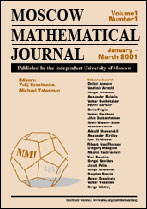|
Elements of the $q$-Askey scheme in the algebra of symmetric functions
Cesar Cuencaa, Grigori Olshanskibcd
a Department of Mathematics, MIT, Cambridge, MA, USA
b Institute for Information Transmission Problems, Moscow, Russia
c Skolkovo Institute of Science and Technology, Moscow, Russia
d National Research University Higher School of Economics, Moscow, Russia
Abstract:
The classical $q$-hypergeometric orthogonal polynomials are assembled into a hierarchy called the $q$-Askey scheme. At the top of the hierarchy, there are two closely related families, the Askey–Wilson and $q$-Racah polynomials. As it is well known, their construction admits a generalization leading to remarkable orthogonal symmetric polynomials in several variables.
We construct an analogue of the multivariable $q$-Racah polynomials in the algebra of symmetric functions. Next, we show that our $q$-Racah symmetric functions can be degenerated into the big $q$-Jacobi symmetric functions, introduced in a recent paper by the second author. The latter symmetric functions admit further degenerations leading to new symmetric functions, which are analogues of $q$-Meixner and Al-Salam–Carlitz polynomials.
Each of the four families of symmetric functions ($q$-Racah, big $q$-Jacobi, $q$-Meixner, and Al-Salam–Carlitz) forms an orthogonal system of functions with respect to certain measure living on a space of infinite point configurations. The orthogonality measures of the four families are of independent interest. We show that they are linked by limit transitions which are consistent with the degenerations of the corresponding symmetric functions.
Key words and phrases:
$q$-Askey scheme, symmetric functions, $q$-hypergeometric orthogonal polynomials.
Citation:
Cesar Cuenca, Grigori Olshanski, “Elements of the $q$-Askey scheme in the algebra of symmetric functions”, Mosc. Math. J., 20:4 (2020), 645–694
Linking options:
https://www.mathnet.ru/eng/mmj779 https://www.mathnet.ru/eng/mmj/v20/i4/p645
|

| Statistics & downloads: |
| Abstract page: | 90 | | References: | 24 |
|




 Contact us:
Contact us: Terms of Use
Terms of Use
 Registration to the website
Registration to the website Logotypes
Logotypes








 Citation in format
Citation in format 